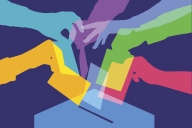You have /5 articles left.
Sign up for a free account or log in.
“It was the best of times, it was the worst of times, it was the age of wisdom, it was the age of foolishness.” So begins A Tale of Two Cities. So it seems to be in higher education today. Federal subsidies have helped us weather the pandemic storm so far. Some states have stepped up their support. Yet, enrollments continued the decade-long overall downward trend. As a result, the percentage of tenured/tenure-track faculty members has continued a downward trend, with only 23.7 percent of faculty members at institutions across the country tenured, and 10.2 percent on a tenure track. Meanwhile, 66.1 percent of faculty members are not part of the tenure-track system. Most of those are part-time adjunct or short-term contract employees, who, in many cases are woefully underpaid (but that is another story).
The number of traditional college-age youth will begin a significant drop in 2025, reflecting the birth-rate decline triggered by the 2008 recession. That will continue for years, followed by a pandemic-triggered drop in births thereafter. These “enrollment cliffs” are further declines on top of the current trend for high school graduates to seek alternatives to college.
It is clear that college is not meeting the great expectations of prospective full-time on-campus students as it did previously. In study after study, we see that among the top priorities of high school students and their parents for college outcomes is the expectation that they will attain a career pathway with at least a middle-class income. With artificial intelligence–driven technologies creating rapid changes in workforce needs, most colleges are not in a position to guarantee those pathways in all degree programs.
Pew Charitable Trust puts the middle income (67 percent to 200 percent of median income) at $42,000 to $125,000. Many college majors fall short of that mark. In a recent study using PayScale’s 2020 College Salary Report, 50 college majors fell below the standard, with many topping out in the $50,000 range. These include some expected areas such as the arts and social service work, but notably they also include such fields as speech and hearing disorder specialists, legal assistants, conservation biology, and medical assistants.
Meanwhile, the cost of attending college continues to rise. The average cost of college has more than doubled in the first 20 years of this 21st century, with an annual growth rate of 6.8 percent. The average cost of college in the U.S. is $35,332 per year, including tuition, books, supplies and living expenses.
No longer is four years the average length of completing a college degree. The U.S. Department of Education reports that fewer than two-thirds of all college students complete their degrees within six years. At $35,000 per year for six years, the investment tops $200,000. The cumulative current student loan debt that is financing these attempts to finish college in the United States totals $1.747 trillion.
Those are the worst of times: dropping residential undergraduate enrollment, dropping revenue due to reduced tuition funds, decreasing full-time permanent faculty and the primary traditional clientele is looking for a higher return on investment through alternative entry to careers.
Yet the best of times is also here. A huge growth in the certificate and certification market is upon us. Lindsay Daugherty, senior policy researcher at the nonprofit, nonpartisan RAND Corporation, reminds us that the traditional college degree is not the only pathway to the middle class:
There are, in fact, many pathways to the middle class, and not all of them run through four-year degree programs. Colleges, continuing education training providers, and even employers now offer an array of short-term credential programs. Most of these require fewer than two years of coursework, and offer opportunities to more or less immediately move into good jobs. Such programs grant individuals credentials like certificates, or short-term educational credentials that often come with college credit; industry certifications, in careers as varied as engineering, nursing, and human resources; and apprenticeships in fields like health care, IT, and welding.
Coursera CEO Jeff Maggioncalda predicts successful college programs will provide certificates embedded in degree programs:
Students will soon expect to be able to get both a degree and a professional certificate from their university, according to the chief executive of one of the world’s largest edtech firms, who believes that the change will be the next major development in online learning. Jeff Maggioncalda, who has run Coursera since 2017, said job-specific training courses for students, developed alongside top businesses, is the biggest growth area for his platform. Although on-campus teaching is returning post-pandemic, Mr Maggioncalda predicted that online learning is here to stay—but it will be in offering short courses for career development where companies such as his can have the most impact initially.
Maggioncalda goes on to say, “I think universities are like: ‘Whoa, we were the only game in town and now very rapidly there’s a lot of other games in town; how can I compete with them?’” His answer is “You’re going to have to change your diet—the world is profoundly changing at a rate we’ve not seen before.”
There are two communities of learners; one is experiencing the best of times; the other is experiencing the worst of times. The traditional residential program is threatened at many institutions while the continuing and professional education programs for adult learners is soaring. Who is digging deeply into the data at your institution to assess enrollments in these two communities of learners? Are they diverging? How are you adapting?





